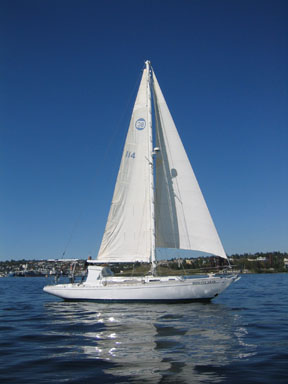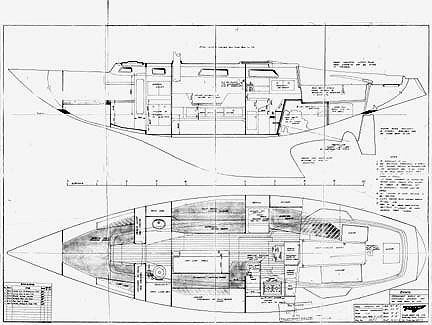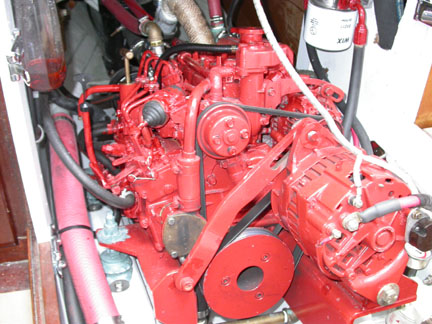
| The Ohlson 38 - Romany Star |

|
| The Romany Star underway on Lake Union after her 2000-2005 refit. |
|
The original interior was designed to sleep seven. There were two berths forward, a settee, a pilot berth on each side of the salon, and a pilot berth on the starboard side aft of the nav station. The interior has been modified to sleep four. Two forward and two in the main cabin. The pilot berths have been turned into precious stowage space. |

|
||||||||||||||||||||||||||||||||||
|
For those into specifications, here are the statistics. What they say is that by modern design standards, the hull is skinny and has long overhangs. These make her a good sailing boat, and pretty. They don't make her roomy. We often wish for more space, but when we get into a tough sailing situation we love how well this boat works. The sail plan is small for a boat this size. The hull is easily driven, and we are reefed down by the time the wind gets to 15 knots. We consider this a huge advantage in a cruising boat, since bigger sails are harder to work with, and cost more money. Whe are now on our second main with no roach. By reducing the mainsail size by about 5%, we reduced the weather helm considerably and ended up with a sail that drives the boat as well as before. This also meant a sail that has less chance to chafe, and again brought costs down. We did find that the fabric in the lower panel of the main never had a chance to wear out when sailing in Pacific Trade Wind conditions, so the new full hoist main was built with the intent that it only be used on the lighter air passages. It still has three reef points though just in case things get rough. We carry the main and jib up all the time. We removed the storm (trysail), storm jib, and the smaller working jib. In their place we added a very heavy second main that is cut the height of the original main with one reef. We also replaced the removable inner forestay with a second permanently mounted roller furling that has a small heavy jib that can be rolled down to a hanky for serious weather. There is a cruising spinnaker which is usually carried without the main when off the wind in lighter air. |
|
||||||||||||||||||||||||||||||||||
|
The original engine was a 15 horsepower Volvo MD2. This engine had been replaced by a 21 horsepower Westerbeke before I purchased the boat. After my first five years of cruising, I was finished with the Westerbeke for a number of reasons. In 2005, the Westerbeke was replaced with a new engine that is a Kubota marinized by Beta Marine. They did a special setup on their standard 20 horsepower engine that gives us a second, high-output alternator. This arrangement means that when our batteries get low, we can top them off in less than two hours, using less than a gallon of diesel. They also provided a remote oil filter that allows doing an oil change without getting a drop in the bilge. The engine will drive the boat up to 7 knots, her maximum hull speed. We usually throttle back to 5 knots where we get about 2.5 hours per gallon of diesel. With our 29 gallon tank, and 15 gallons on deck, that gives us a range of about 550 miles. |

|
||||||||||||||||||||||||||||||||||
| Additional Systems and Equipment | |||||||||||||
| Batteries | We carry a house bank of four 12 volt Golf Cart batteries that provide 500 amp hours of 12 volt power. Using these conservatively we can go about three days before charging. There is also an additional battery reserved for starting the engine. | ||||||||||||
| Solar Panels | There is an 495 watt array of solar panels mounted over the cockpit. This provides welcome shade, and most of our electrical power. The solar can keep up with our needs most of the time, we have gone as long as a month without starting the engine while at anchor. | ||||||||||||
| Hot Water | We have pressurized hot and cold water. The water is heated through waste heat from the engine, or from the diesel cabin heater. | ||||||||||||
| Interior Heat | This Webasto heater uses about 1.5 gallons of diesel in 24 hours. It heats an anti-freeze solution that is circulated through a radiator in the boat which provides 10,000 BTU of forced air heat in the cabin. | ||||||||||||
| Desalinator | Our drinking and wash water comes from desalinated ocean water. The desalinator will produce our daily usage of about six gallons in two hours. | ||||||||||||
| Refrigerator Freezer | There is a 2.5 cubic foot refrigerator in the galley with an additional 1 cubic foot of freezer space below it. | ||||||||||||
| Dinghy | Our dinghy is inflatable, with a fiberglass bottom. The engine is a 10 horsepower. It is a quick little package for trips away from the boat. | ||||||||||||
| Self Steering |
|
||||||||||||
| Electronics |
|
||||||||||||
Home